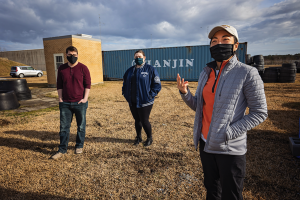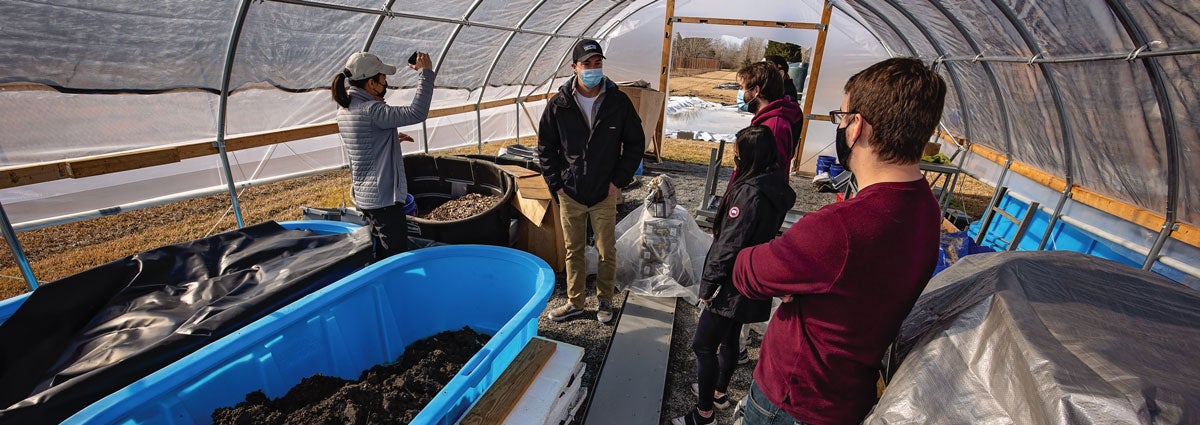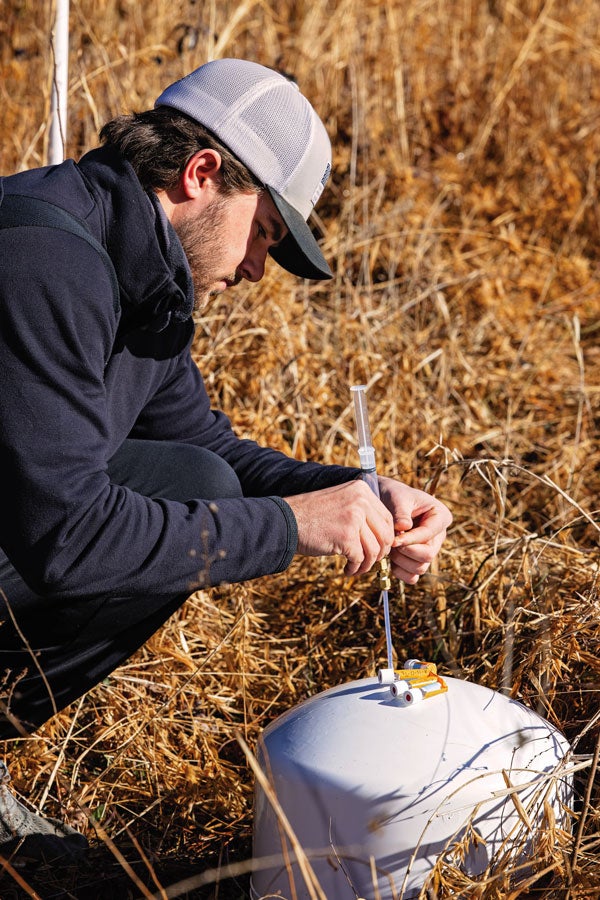in a bag at the VOA West Research Lot.
Going West

Towering antennas dominate a pristine skyline, serving as landmarks for local wildlife instead of redirecting transmissions that formerly reached sites as far away as Cuba, South America and Europe.
The previous home of the Edward R. Murrow Transmitting Station — a control site for the U.S. government’s Voice of America initiative — has fulfilled a new purpose since East Carolina University leased the property in 2001.
The site, which at one point during its history served as a toxic waste dump, now brings research to life, as faculty and students from biology, engineering and geology congregate at ECU’s West Research Campus to answer the biggest environmental problems plaguing eastern North Carolina.
Growing research
“I’ll tell you one thing I think is really cool,” ECU biology professor Carol Goodwillie said while describing the campus. “There are at least three types of carnivorous plant species out there — pitcher plants, sundews and bladderworts. That’s not something I think many people get to encounter on their way to work.”
Instead of being surrounded by the buzzing of Greenville’s lively Uptown District or the cool shade of the campus mall, visitors to the West Research Campus are more likely to be greeted by knee-high grass, pollen and maybe a few unwelcome insects.
That’s just how Goodwillie and her biology students like it.

THIS SITE COULD BE A JEWEL IN ECU’S CROWN AND SOMETHING THAT WE FEATURE. … THERE’S NO REASON IT CAN’T BE A MORE VALUABLE FACILITY AND PUBLIC RESOURCE IN THE FUTURE.
– Carol Goodwillie, ECU biology professor
The architect of the campus’ longest running research project, Goodwillie leads an ecological study of the wetland plant community. For nearly 20 years, her lab has observed 96 permanently marked plots — within an experiment nearly the size of a football field — and identified, counted and catalogued every present plant species.
“When you’re studying ecological processes, you need to study them over a long period of time to see how things are playing out,” Goodwillie said. “We’re looking at the effects of fertilization and mowing on the plant community.”
Goodwillie said that human activities can unintentionally add nutrients from particulates from industrial pollution and fertilizer runoff into the environment.
“What we’ve found is that we’re losing plant diversity when we fertilize the plots through time,” Goodwillie said. “They contain fewer types of plants because certain species are better able to take up those nutrients, becoming ‘bully’ species that outcompete others.
“It also turns out that a lack of wildfires reduces diversity as well. We need wildfires to keep the playing field level and wipe out strong competitors so that more species can exist.”
So how does this affect eastern North Carolina wetlands? “We’re losing native wetland species,” Goodwillie said. “When we inject nutrients into environments that are not built for it, we lose these species because other plants that were not designed to thrive in wetlands can now get a foothold and outcompete them.
“It’s a pattern that’s absolutely striking,” she said. “We’re seeing less and less of some of these quite beautiful and rare species found only in our wetlands.”
Historical significance
Long before an undergrad researcher recorded the first plant species as part of Goodwillie’s project, the site that would one day become ECU’s West Research Campus played a pivotal role in the country’s military endeavors.
Opened in 1968, the Greenville location was part of a three-site setup for the Voice of America initiative that aimed to shape public opinion during the Cold War.
Chosen for its remoteness, proximity to a reliable power source and its flat terrain, Greenville’s radio receiving station received shortwave broadcasts from government-funded and nonmilitary agencies for international programming. Its target locations included Cuba, Latin America, the Caribbean and North Africa. In conjunction with Site A in Beaufort County and Site B in Grimesland, Greenville’s Site C location received program transmissions from Washington, D.C., and distributed them to the two local sites before reaching an international audience.
At the time, it was the world’s largest radio transmitting facility and used the latest broadcasting and transmission technology.
Started to combat Nazi propaganda in 1942, the VOA is the largest U.S. international broadcaster, providing news and information in more than 40 languages to an audience of more than 280 million, according to the agency.
As technology changed, so did the need for the Greenville VOA site. Officially decommissioned in 1999, it was sold to ECU two years later.
The site’s purpose has evolved from leading the government’s charge against communism to educating eastern North Carolina’s future scientists, proving that no problem can go unsolved as long as there’s enough resolve behind the team seeking to find an answer.
Engineering solutions
Helping preserve the region’s natural habitat is just what College of Engineering and Technology assistant professor Natasha Bell was built to do.
An ecological engineer, Bell works in a lab that identifies ways to use natural microbial and plant processes to provide clean water. Since these processes already exist in nature, they should be available to supply clean water with more ecofriendly solutions than traditional remediation methods.
“We need clean water, especially as our population grows,” Bell said. “That fueled my interest in how we can use sustainable, resilient practices to clean our water and not have to rely on methods that involve high energy use or high cost.”

Above, Natasha Bell works with students at the West Research Campus. The
class was working with wastewater management techniques.
Armed with a rudimentary greenhouse, a rainwater-fed pond, three bioreactor cells and six constructed wetland cells, Bell’s students are taking science out of the classroom and testing it in the field.
Bell believes the data collected by her lab can help provide insights into the barriers that keep companies and other stakeholders from using ecological-based treatment technologies to clean water.
“The technologies we’re testing are great and there’s a lot of interest, but there are still many unanswered questions about how they function and how to maintain them,” Bell said. “Some stakeholders are hesitant to put in green technologies. My hope is that once we get the data and share it with the community, people will start putting these green infrastructure practices to use.”
 Crown jewel
Crown jewel
What their projects have in common is the idea of integrating undergraduate students into their work at the West Research Campus.
ECU alumnus Matt Hodges, a Kinston native who graduated in 2020 with his master’s in biology, had a unique experience at the campus — as a student and a teacher. “When I got to ECU my plan was to go into physical therapy,” Hodges said. “I took a general education course with Dr. Goodwillie. I thought it was something I’d just take for a credit.”

Top, students learn about wastewater management techniques while at the West Research Campus. Above, graduate research assistant Joseph Weddington collects gas samples.
Hodges worked as a teaching assistant for Goodwillie last fall and was responsible for data collection at the research site.
“We had such a diverse group of students,” Hodges said. “Some looked like they hadn’t been outside since recess. However, within two days they’re out learning and identifying plant species and working together as a team toward a common goal.”
That diversity is a key component for the West Research Campus. With interdisciplinary scientists from various departments, the site provides a thriving space for researchers from multiple backgrounds.
“ECU doesn’t allow for researchers to stay in their silos,” Bell said. “There’s a collaborative feeling here. The West Research (Campus) is an example of that. It’s a physical representation of that Pirate spirit.”
Goodwillie sees great things for the future of the site.
“I’ve always had a dream that this site could be a jewel in ECU’s crown and something that we feature,” she said. “How many campuses have a field site like this just eight miles from campus with all this potential? There’s no reason it can’t be a more valuable facility and public resource in the future.”